Save the Bulbs! A Brief History of Old House Gardens
It may have been a crazy idea — a catalog devoted to old bulbs, the kind that every other catalog in the country was dropping in favor of whatever was new, New, NEW! But everyone knows that new isn’t always better, and plenty of people like old houses and classic cars and heirloom tomatoes. Many of the old bulbs I’d grown and loved were tough, beautiful, and different, but they were gradually disappearing from catalogs — and I knew if I didn’t do something, they could be lost forever.
So here’s a brief history of that crazy idea and how it has grown since then thanks to the help of thousands of “friends and partners” who’ve agreed with us that these bulbs are just too wonderful to let go extinct. Customers, garden writers, growers, our incredible OHG crew, and more — thank you for making the first twenty years of Old House Gardens not only possible but a joy. With your help, we’ll keep growing, improving, having fun, and saving more amazing old bulbs!
— Scott Kunst, Owner and Head Gardener
In the Beginning: The Purple Years
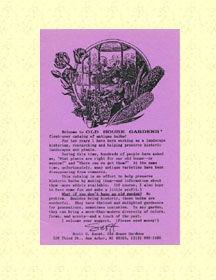
1993
Determined to save ‘Prince of Austria’ tulip, and armed with a preservation degree and a lifetime love of gardening, Scott mails 500 copies of his first catalog. Among its six half-size pages are Louisiana-grown daffodils from Sisters’ Bulb Farm. Complete strangers send money and encouragement, and Scott packs and ships every order himself from his old-house basement.
|
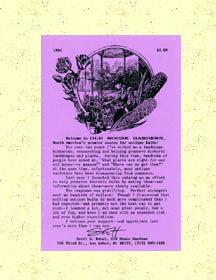
1994
Happy customers and a couple of savvy garden writers (thanks, Mariana and Cynthia!) spread the word about us. Sales triple, causing all sorts of good problems. A kind-hearted neighbor pitches in to save the shipping season. Among the thirteen hyacinths we offer, six go “commercially extinct” by the end of the decade, including the incomparable ‘Distinction’.
|
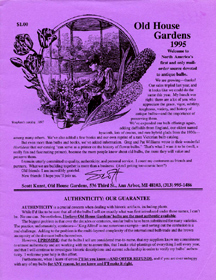
1995
A young Dutchman, Piet Goemans, catches our enthusiasm for historic bulbs and becomes our right-hand man in the Netherlands. Garden Design features full-page photos of our Tulipa marjolettii and ‘Princess Elizabeth’. We move shipping from the basement to Scott’s barn-like garage and discover just how cold October mornings can be.
|
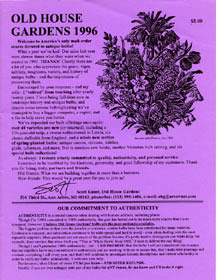
1996
Giddy with optimism, Scott leaves teaching to devote full time to landscape history and heirloom bulbs. Thanks to Jane, world’s best wife, no one starves. We offer our first few spring-planted bulbs: 2 tuberoses, 3 dahlias, 3 cannas, 3 glads (including ‘Atom’ which becomes an all-time customer favorite), and that’s about it.
|
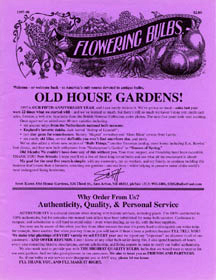
1997-98
The country’s leading consumers-reporting magazine gives our bulbs their highest rating. We offer our first three bulbs from the Hortus Bulborum, including Tulipomania-relic ‘Zomerschoon’. Scott and friends convince the American Daffodil Society to add a section for historic daffodils to all shows, and the ADS appoints him chair of their new Historic Daffodils Committee.
|
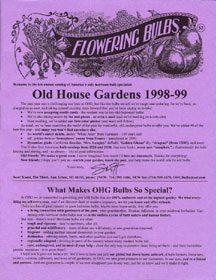
1998-99
We add our first few pages of color photos, and a neighborhood high school kid helps us launch a very simple website. Superstar garden-writers Ken Druse, Ann Lovejoy, and Bill Finch praise our bulbs — and almost every fall since then Bill reminds his Mobile Press-Register readers that we offer “the best collection of traditional Southern bulbs in the country.”
|
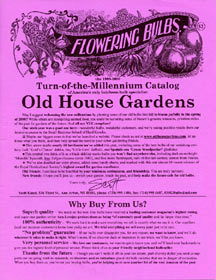
1999-2000
Young Charlie the cat comes to work and soon advances to VP for Taking it Easy. Our suggestion to welcome the new millennium by planting heirloom bulbs makes the front page of The Wall Street Journal. The unforgettable Flora Ann Bynum asks Scott to speak at the Old Salem “Restoring Southern Gardens and Landscapes” conference.
|
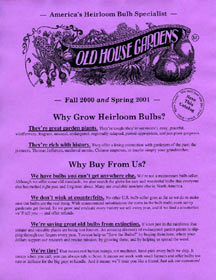
2000-01
Mount Vernon, the Smithsonian, the Denver Botanic Garden, and Hearst Castle all grow our bulbs. The renowned Seed Savers Exchange adds two pages of them to their catalog. We offer zone-6 hardy ‘Carolina Primrose’ gladiolus and the last of our five reprints of historic American bulb catalogs.
|
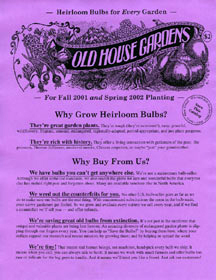
2001-02
Pittsburgh’s historic Phipps Conservatory honors Scott with its 2001 Flora Award. A display of our tulips on Park Avenue inspires The New York Times’ Verlyn Klinkenborg to write, “With luck, the current fashion for heirloom plants . . . will turn out not to be a fashion at all, but a continuing expression of the need for genetic conservation, for keeping the past alive in the most literal sense possible.”
|












